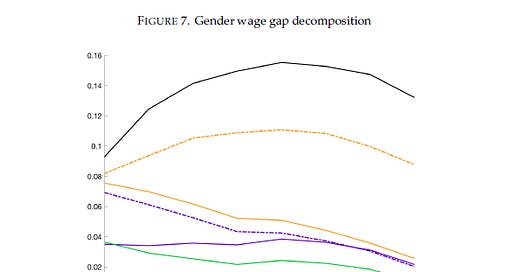Wage and Employment Discrimination by Gender in Labor Market Equilibrium
Author: Pengpeng Xiao
Abstract: This paper develops an equilibrium search model to study mechanisms underlying the life-cycle gender wage gap: workers’ skill accumulation, amenity preferences, and employers’ statistical discrimination in wage offers and hiring. Estimating the model on administrative employer-employee data from Finland, I find that statistical discrimination accounts for 44% of the gender wage gap in early career, whereas gender differences in labor force attachment explain most of the gap in late career. Policy counterfactuals highlight the importance of employers’ decisions on both wage and employment margins; requiring equality on one margin might have unintended consequences on the other margin
Pages: 56
Date Added: 9/22/2022, 9:54:50 AM
Reading Notes:
Objective: To develop an equilibrium search model that includes skill accumulation, job amenity preferences, and employer discrimination by gender
Importance: The model includes several features not usually combined- employer capacity constraints and competition between men and women for jobs, human capital, job preferences, and statistical discrimination. All of these elements are important for understanding continued wage gaps
Background: Finland has long maternity leave (18 months) and job guarantee. State-owned enterprises must reserve 40% of board seats for female directors
Data & Key Variables: Finnish Longitudinal Employer-Employee matched data (FOLK) 1988-2016: demographics, employment, child birth dates & parental leave
Finnish Quality of Life Surveys: Work amenities and disamenities - PCA by occupation
Structure of Earnings Survey (SES): Earnings
Sample: Those that earn masters' degrees between 1988-2005
Methodology: Job search model with Simulated Method of Moments
Counterfactuals: Daddy time reserved from parental leave, gender quotas at high wage jobs, equal pay for men & women in same occupation
Results:
Empirical points of interest: firm transitions for women dip in year before birth, spike after. Part time employment rises
Equalizing preferences for job amenities decreases gender gap by most in model
In counterfactuals, reserving paternity leave has biggest effect on earnings gap
Key Table/Figure:



